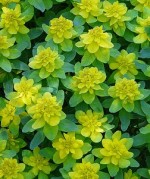
Cushion spurge is a clump-forming herbaceous perennial native to Central and southeastern Europe, and Asia Minor, and a member of the Euphorbiaceae family that also includes pointsetta, rubber plant, and caster oil plant. It grows 12-18″ tall and and has sturdy, erect stems that exude a milky sap that can irritate the skin especially when exposed to the sun. Plants form a compact dome of medium green, oblong, succulent leaves that are downy, up to 2″ long, and turn bronzy red in the fall. In spring, the surface of the plant is covered with terminal cymes tiny greeenish, apetalous flowers made conspicuous by showy persistent bright yellow/lime green bracts that turn red with maturity. Tolerant of drought, rabbits, and deer, cushion spurge is easily vegetatively propagated or grown from seed and often reseeds itself in the garden. It is an excellent choice for rock gardens or containers. The genus name, Euphorbia, probably honors Euphorbus, the physician to the King of Maurentania in ancient times. The specific epithet, polychroma, comes from the Greek words poly meaning many, and khromos meaning colored.
Type: Herbaceous perennial
Bloom: Small yellow flowers are produced in clusters surrounded by greenish-yellow bracts in spring.
Foliage:Medium green succulent leaves that turn bronzy red in the fall.
Size: 12-18� H x 18�
Light: Full sun in the North, afternoon shade or part sun in the South
Soil: Average, dry to medium moist, well-drained
Hardiness: Zones 4-8
Care: Low maintenance
Pests and Diseases: None of significance
Propagation: Seed, stem cuttings, division
Companion plants: Coreopsis ‘Zagreb’ , Geum coccineum, horned violets (Viola cornut), Nepeta ‘Six Hills Giant’, moss pink (Phlox sublata), rock cress (Aubrieta spp.), blue fescue (Festuca cinerea), Jacob�s ladder (Polemonium caeruleum).
